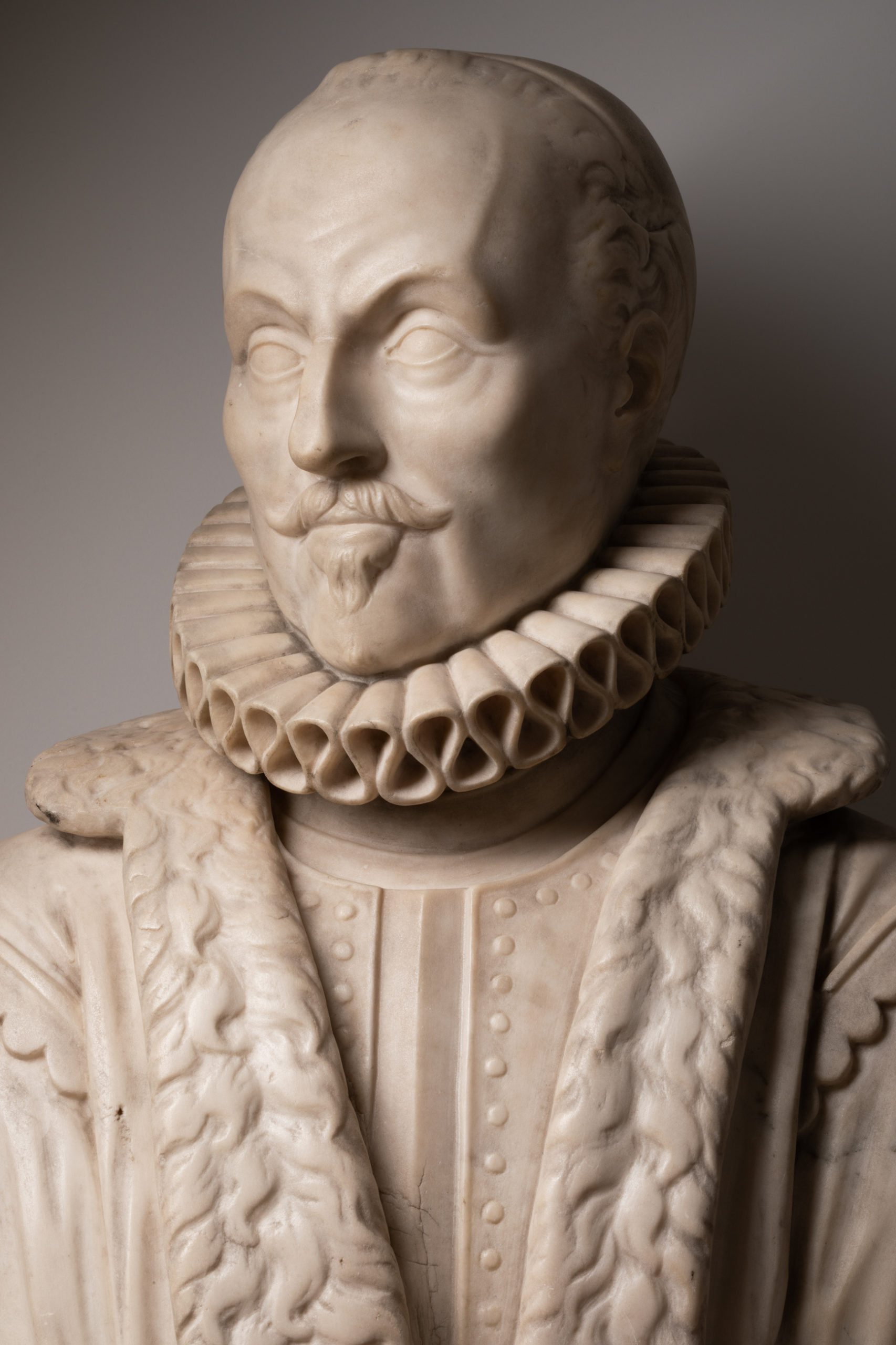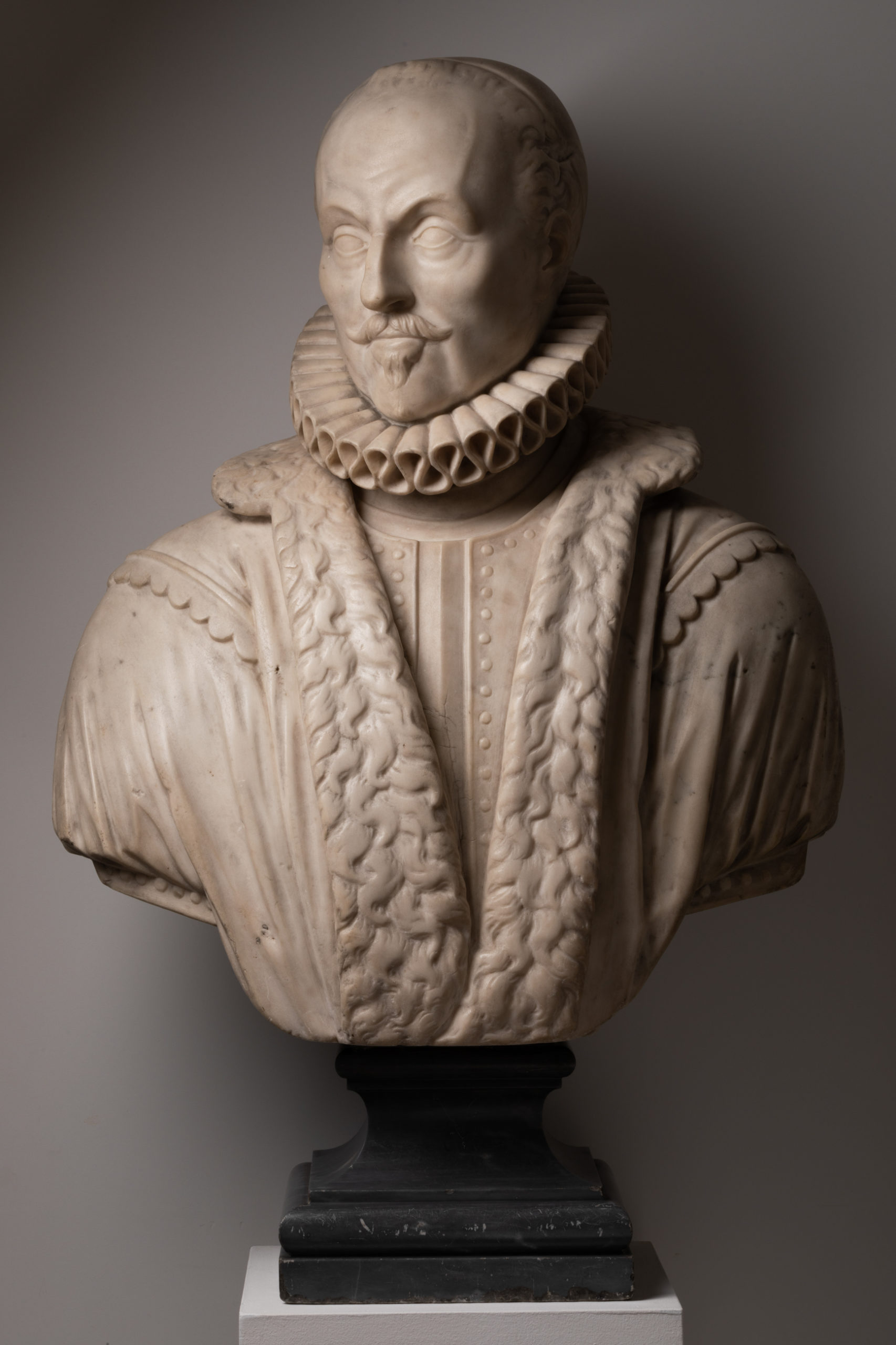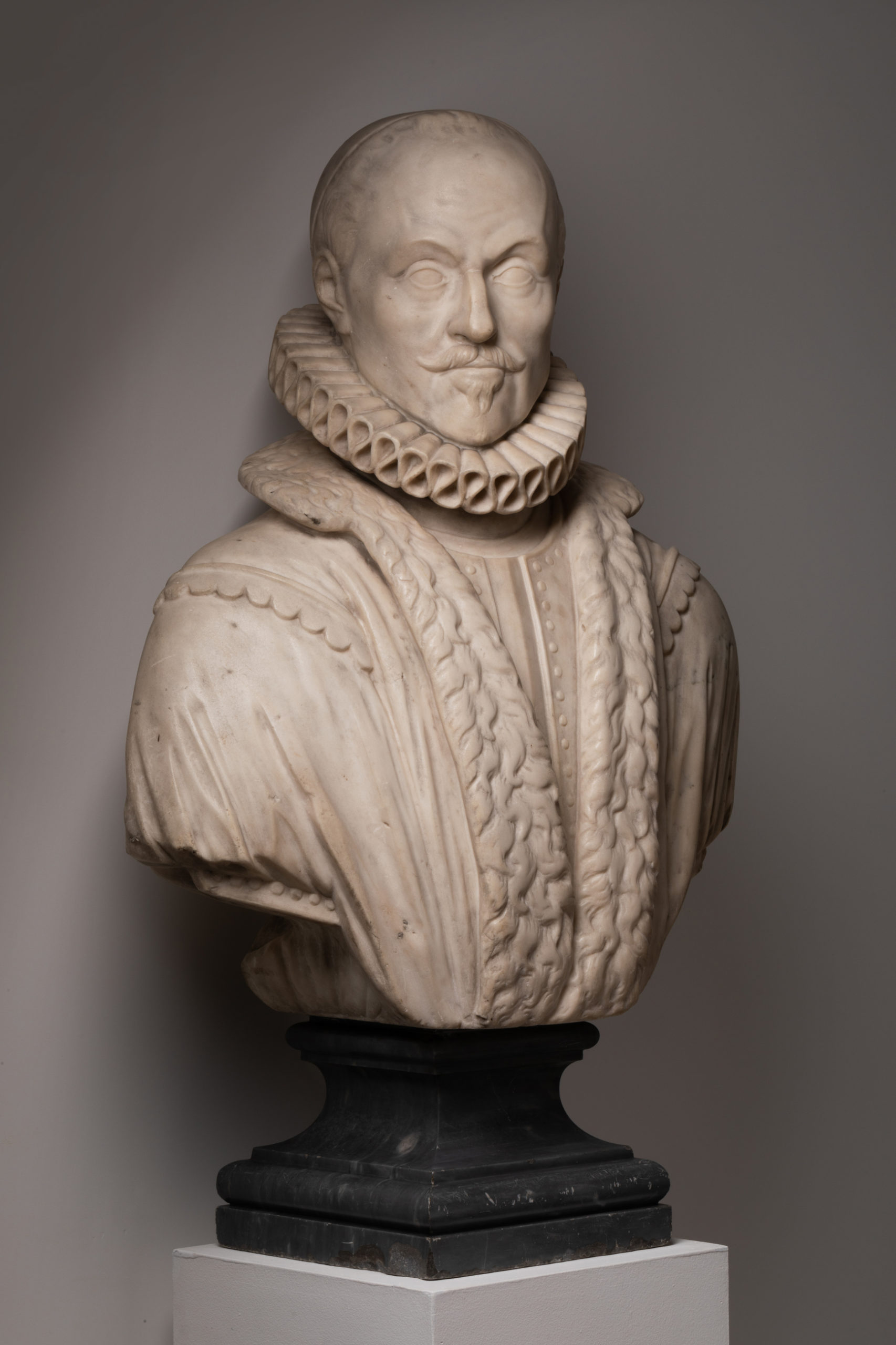Description
Ce majestueux buste en marbre représente un homme d’âge mûr, vu de face avec la tête légèrement tournée vers la droite. L’homme porte une fraise autour du cou, une armure et un grand col de fourrure qui descend jusqu’en bas du buste. Le visage est grave, sérieux et solennel. L’homme arbore une petite moustache légèrement relevée, une barbichette et porte sur le haut du crâne un petit bonnet. Les différents éléments de ce buste nous laissent à croire qu’il s’agit de la représentation d’un homme important, d’origine noble, à la carrière militaire longue et particulièrement dévot. Après l’étude de plusieurs portraits nous pouvons avancer le nom de Guillaume d’Orange.
Guillaume de Nassau d’Orange (Willem van Oranje en Néerlandais) était un noble aux multiples talents : d’abord loyal serviteur de la couronne d’Espagne, il se rebelle contre celle-ci pour devenir un « père de la nation », un des fondateurs du nouvel état hollandais, dont il n’avait pourtant jamais envisagé la création.
Né en 1533 au château de Dillenburg en Allemagne de parents luthériens, Guillaume hérite en 1544 de la principauté d’Orange. Mais pour valider cet héritage Charles Quint (roi d’Espagne et Empereur du Saint-Empire romain Germanique depuis 1519) exige que le jeune prince soit éduqué dans la foi catholique à la cour royale de Bruxelles. C’est dans cet environnement que le jeune Guillaume apprend le français, l’espagnol, l’italien, le néerlandais (qu’il ne parlera jamais couramment), la rhétorique et la diplomatie. Devenu rapidement un des nobles les plus influent des Pays-Bas, il obtient à partir de 1555 des fonctions importantes : il est commandant en chef des armées, membres du Conseil d’Etat, chevalier de l’Ordre de la Toison d’or et stathouder de Hollande, Zélande et d’Utrecht. Mais sa relation avec Philippe II, successeur de Charles Quint sur le trône d’Espagne, se dégrade rapidement. Devenu porte-parole de l’opposition nobiliaire, le prince d’Orange plaide pour une modération dans la lutte contre l’hérésie protestante, une liberté de culte pour les sujets des Dix-Sept Provinces, il s’oppose aux nouveaux fonctionnaires de l’administration qui ont acquis des positions au détriment des nobles et s’oppose au nouvel impôt imposé par l’Espagne qui veut profiter du riche commerce hollandais pour financer d’incessantes guerres.
En 1566 un nouveau gouverneur est envoyé d’Espagne : le duc d’Albe. Avec la mise à mort des comtes d’Egmont et de Hornes (catholiques et chevaliers de la Toison d’or ayant ouvertement critiqué la politique royale) ; la répression espagnole s’intensifie. Identifié comme un autre chef de la rébellion des « gueux », Guillaume d’Orange doit fuir en Allemagne où il se convertit au calvinisme et monte une armée. À partir de 1568, il lance plusieurs campagnes militaires aux Pays-Bas pour mettre un terme au pouvoir du duc d’Albe et mettre en place un gouvernement « local ». Cette lutte politique et religieuse se mène également à travers des estampes, des pamphlets et des chansons, notamment le Wilhelmus (hymne national hollandais actuel) qui est né pendant cette lutte et s’inspire de la vie de Guillaume.
Aujourd’hui encore les historiens sont d’accord pour admettre que c’est grâce à la persévérance, et la ténacité de Guillaume d’Orange que les rebelles ont tenu bon en Hollande et en Zélande. En 1576, la paix est même instaurée avec les provinces restées fidèles à la couronne espagnole avec la Paix de Gand. L’idéal de Guillaume est proche : le rétablissement et l’unification des Dix-Sept Provinces des Pays-Bas gouvernées par la noblesse locale, une tolérance religieuse et une liberté de culte. Mais cette unité nouvelle n’a pas tenu longtemps.
En 1580, fait rarissime dans la diplomatie européenne, Philippe II émet contre Guillaume un édit de proscription, l’accuse de trahison, d’ingratitude, d’hérésie, le déclare « ennemi de la race humaine » et met sa tête à prix. Le prince d’Orange répond en publiant son Apologie : un document dans lequel il repousse les accusations du roi, justifie ses choix politiques et personnels et défend son droit de se rebeller contre la tyrannie et l’absolutisme espagnol. Il présente son ouvrage en 1581 devant l’assemblée des Etats généraux des Pays-Bas à Delft et celui-ci sera traduit puis diffusé dans les cours européennes. Révoltés par la condamnation du stathouder, les Etats généraux rédigent l’Acte de La Haye. Ces deux écrits ont une place majeure dans l’Histoire des Pays-Bas : ils légitiment la révolte et proclament la déchéance du roi d’Espagne, devenu indigne de gouverner les Dix-Sept Provinces.
Après avoir échappé à plusieurs tentatives d’assassinat, Guillaume d’Orange est abattu le 10 juillet 1584 par Balthazar Gérard, un catholique se faisant passer pour un huguenot français. Attristé et déçu jusqu’à sa fin de ne pas avoir libéré toutes les provinces hollandaises de la domination espagnole (notamment la Belgique actuelle), Guillaume reste un personnage central de cette rébellion. Moins de 25 ans après sa mort, les provinces révoltées se transforment en une République, déjà consciente et reconnaissante envers ce héros, fondateur de la nation.
Le prince voulait être enterré à Breda auprès de sa première épouse et de ses ancêtres, mais la ville étant encore occupée par les Espagnols, Guillaume est enterré à Delft dans une tombe simple et sobre. Ce n’est qu’en 1614, pendant la trêve de Douze ans qu’un véritable monument funéraire est construit par le célèbre sculpteur et architecte hollandais Hendrick de Keyser. Composé d’un gisant en marbre de Guillaume d’Orange et d’une statue en bronze du prince en chef de l’armée ; ce majestueux tombeau devient dès lors la référence dans la représentation sculpturale du Taciturne. Les municipalités, les nobles et les membres de la famille royale de Hollande ont régulièrement rendu hommage à ce héros national, à travers des commandes de sculptures de Guillaume, souvent inspirés de son tombeau. Nous pouvons citer en exemple Willem III qui, en 1683, commande une série de 6 bustes en marbre représentant ses ancêtres dont le prince d’Orange. Ce dernier est aujourd’hui dans les Collections Royales et visible au Palais de Soestdijk.
Représentation idéalisée d’un héros de la nation, ce buste dégage une aura de noblesse. L’état de conservation nous laisse admirer la finesse du marbre et des détails de ce portrait sculpté, très certainement commandé pour rendre hommage au prince d’Orange.
________________________________________
This majestic marble bust represents a middle-aged man, seen from the front with his head turned slightly to the right. The man wears a strawberry around his neck, a suit of armor and a large fur collar that goes down to the bottom of his chest. The face is grave, serious and solemn. The man wears a small moustache slightly raised, a goatee and wears a small cap on the top of his head. The different elements of this bust lead us to believe that it is the representation of an important man, of noble origin, with a long military career and particularly devout. After the study of several portraits we can advance the name of William of Orange.
William of Nassau of Orange (Willem van Oranje in Dutch) was a nobleman of many talents: at first a loyal servant of the Spanish crown, he rebelled against it to become a “father of the nation”, one of the founders of the new Dutch state, the creation of which he had never envisaged.
Born in 1533 in the castle of Dillenburg in Germany to Lutheran parents, William inherited the principality of Orange in 1544. But to validate this inheritance Charles V (King of Spain and Emperor of the Holy Roman Empire since 1519) requires that the young prince be educated in the Catholic faith at the royal court in Brussels. It was in this environment that the young William learned French, Spanish, Italian, Dutch (which he would never speak fluently), rhetoric and diplomacy. He quickly became one of the most influential nobles in the Netherlands, and from 1555 onwards he held important positions: he was commander-in-chief of the armies, a member of the Council of State, a knight of the Order of the Golden Fleece and stathouder of Holland, Zeeland and Utrecht. But his relationship with Philip II, successor of Charles V on the throne of Spain, deteriorates quickly. Having become the spokesman of the noble opposition, the Prince of Orange pleaded for moderation in the fight against Protestant heresy, freedom of worship for the subjects of the Seventeen Provinces, he opposed the new civil servants of the administration who had acquired positions to the detriment of the nobles, and he opposed the new tax imposed by Spain, which wanted to take advantage of the rich Dutch trade to finance incessant wars.
In 1566 a new governor was sent from Spain: the Duke of Alba. With the killing of the Counts of Egmont and Hornes (Catholics and Knights of the Golden Fleece who openly criticized the royal policy), Spanish repression intensified. Identified as another leader of the “gueux” rebellion, William of Orange had to flee to Germany where he converted to Calvinism and set up an army. From 1568, he launched several military campaigns in the Netherlands to put an end to the power of the Duke of Alba and set up a “local” government. This political and religious struggle was also carried out through prints, pamphlets and songs, notably the Wilhelmus (the current Dutch national anthem) which was born during this struggle and was inspired by William’s life.
Even today, historians agree that it is thanks to the perseverance and tenacity of William of Orange that the rebels held out in Holland and Zeeland. In 1576, peace was even established with the provinces that remained loyal to the Spanish crown with the Peace of Ghent. William’s ideal is close: the re-establishment and unification of the Seventeen Provinces of the Netherlands governed by the local nobility, religious tolerance and freedom of worship. But this new unity did not last long.
In 1580, a rare event in European diplomacy, Philip II issued an edict of proscription against William, accusing him of treason, ingratitude and heresy, declaring him an “enemy of the human race” and putting a price on his head. The Prince of Orange responded by publishing his Apology: a document in which he repudiated the king’s accusations, justified his political and personal choices, and defended his right to rebel against tyranny and Spanish absolutism. He presented his work in 1581 before the assembly of the States General of the Netherlands in Delft and it was translated and then distributed in the European courts. Revolted by the condemnation of the stathouder, the States General drafted the Act of the Hague. These two writings have a major place in the history of the Netherlands: they legitimize the revolt and proclaim the deposition of the king of Spain, who had become unworthy to govern the Seventeen Provinces.
After having escaped several assassination attempts, William of Orange was shot on July 10, 1584 by Balthazar Gérard, a Catholic posing as a French Huguenot. Saddened and disappointed to the end that he did not liberate all the Dutch provinces from Spanish rule (including present-day Belgium), William remains a central figure in this rebellion. Less than 25 years after his death, the revolted provinces were transformed into a Republic, already conscious and grateful to this hero, founder of the nation.
The prince wanted to be buried in Breda near his first wife and his ancestors, but the city was still occupied by the Spanish, so William was buried in Delft in a simple and sober tomb. It was not until 1614, during the Twelve Year Truce, that a real funerary monument was built by the famous Dutch sculptor and architect Hendrick de Keyser. Composed of a marble recumbent of William of Orange and a bronze statue of the prince in chief of the army, this majestic tomb became the reference in the sculptural representation of the Taciturn. Municipalities, nobles and members of the Dutch royal family regularly paid tribute to this national hero, through commissions for sculptures of William, often inspired by his tomb. We can cite as an example Willem III who, in 1683, commissioned a series of 6 marble busts representing his ancestors including the prince of Orange. The latter is now in the Royal Collections and can be seen in the Soestdijk Palace.
Idealized representation of a hero of the nation, this bust gives off an aura of nobility. The state of conservation allows us to admire the fineness of the marble and the details of this sculpted portrait, most likely commissioned as a tribute to the Prince of Orange.




